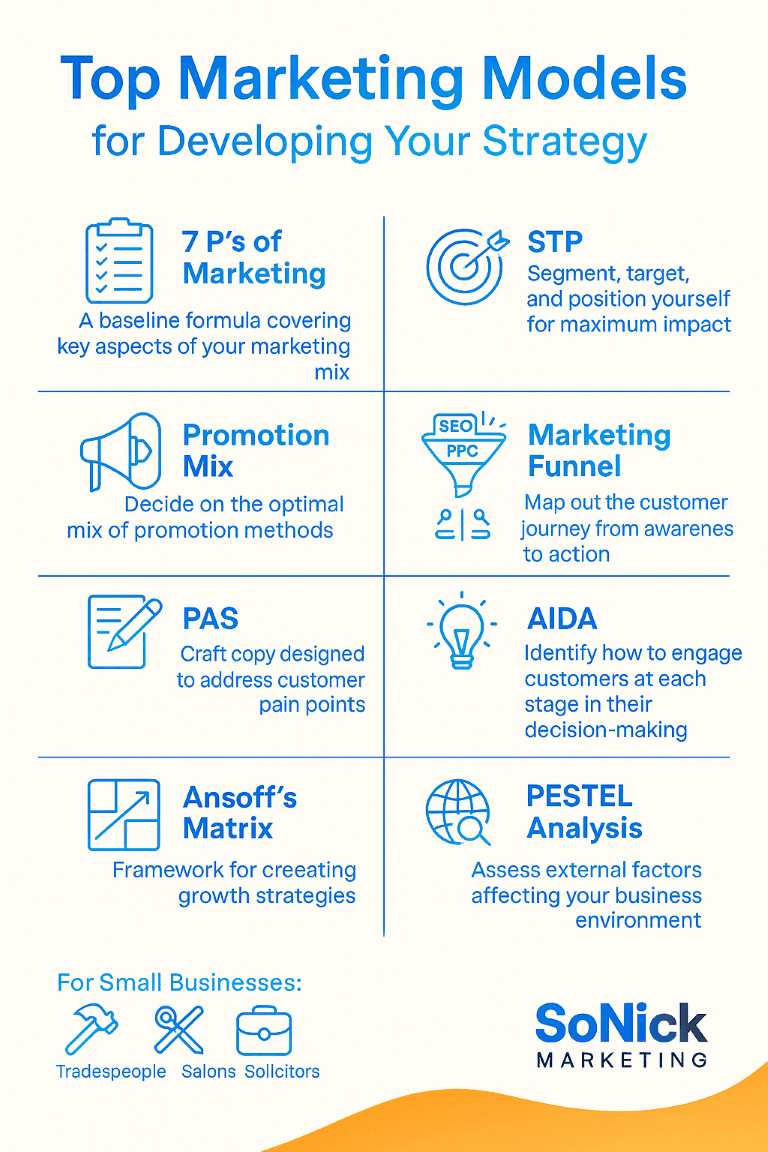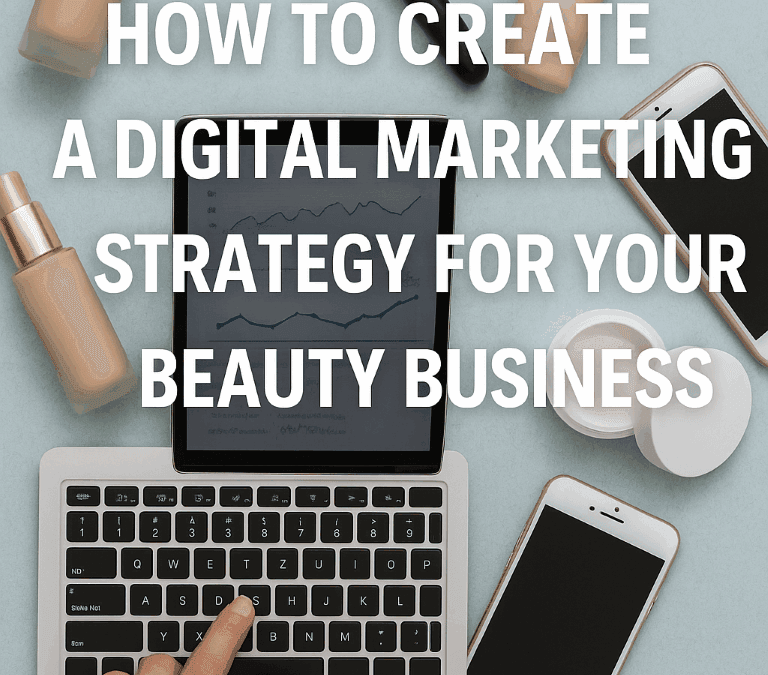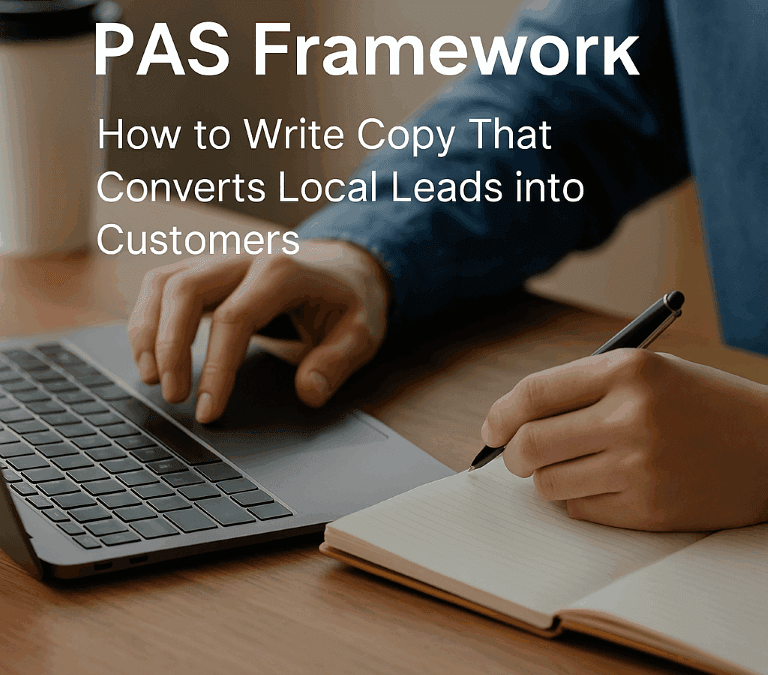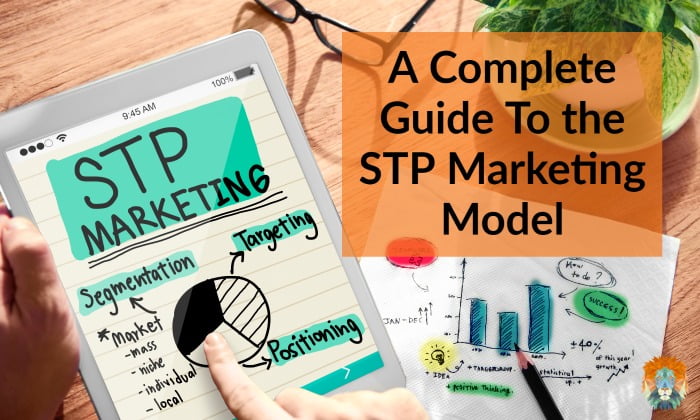As a small business owner—whether you’re a plumber, salon owner, solicitor, or tradesperson—you’ve probably heard conflicting advice about what’s “essential” for growing your business. But there’s one thing every successful local business has in place, and that’s a solid marketing strategy.
More than just a buzzword, your marketing strategy is the foundation of your visibility, growth, and lead generation. And behind every great strategy? A reliable marketing model.
In this guide, we’ll walk you through what marketing models are, how they support your business growth, and which ones are best suited for small businesses that rely on local SEO, PPC, and website-driven lead generation.
What Is a Marketing Model?
A marketing model is a proven framework used to understand your market, define your value, and better connect with your customers. Developed by business experts and tested across industries, these models simplify decision-making and help you build effective, sustainable marketing strategies.
Think of them as roadmaps—easy to follow, easy to adapt, and essential for navigating modern digital marketing, especially if you’re juggling your own SEO, Google Ads, and website updates.
📈 Whether you’re just starting out or looking to optimise your local marketing efforts, these models can help focus your energy on what works.
Why Small Businesses Need Marketing Models
If you’re running a local business, time is precious. Marketing models save time and money by helping you:
- Identify the most profitable customer segments
- Choose the right channels (SEO, PPC, social media, etc.)
- Create consistent messaging across your website and campaigns
- Focus your budget on what actually converts
Still unsure? Explore the benefits of SEO for small businesses to see how structured marketing drives real results.
Top Marketing Models for Local Business Success
These are the marketing models we use regularly at SoNick Marketing when crafting strategies for trades, salons, legal services, and more.

1. 7 Ps of Marketing
The classic model—and a brilliant place to start.
- Product
- Price
- Place
- Promotion
- People
- Process
- Physical Evidence
The 7 Ps force you to think holistically about how your business operates and how it’s presented online. If you’re redesigning your website or rethinking your messaging, this is your blueprint. Read more in our post on web design best practices.
2. STP (Segmentation, Targeting, Positioning)
Want better leads? Start here.
- Segmentation: Break your market into customer types.
- Targeting: Choose which group to focus on.
- Positioning: Craft your message to stand out.
STP is ideal if you’re planning a local SEO strategy or refining your Google Ads campaigns.
3. Marketing Funnel
Your customer’s journey—from “never heard of you” to “repeat buyer”—can be mapped and optimised using a funnel.
The key stages:
- Awareness
- Interest
- Consideration
- Purchase
- Retention
It’s essential when building out content, landing pages, or PPC remarketing campaigns.
4. AIDA: Attention – Interest – Desire – Action
AIDA is your go-to for writing compelling website and ad copy that leads to sales.
Use this when:
- Writing a homepage
- Creating Google Ads
- Designing a plumbing landing page
- Crafting lead magnets or calls to action
Need help? Explore our website copywriting services.
5. Ansoff Matrix
Ready to grow beyond your current offering or market? Ansoff helps you decide how:
- Market Penetration (Sell more to existing customers)
- Product Development
- Market Development
- Diversification
Great for trades or legal firms expanding into new locations or services—see our combined SEO and PPC packages to support new market growth.
6. SWOT Analysis (Strengths, Weaknesses, Opportunities, Threats)
This is one of the simplest yet most effective models to guide your strategy. Use it to:
- Plan your next campaign
- Identify opportunities in your market
- Protect against competitor threats
Pair your SWOT insights with our free SEO audit to uncover growth areas.
7. PAS (Problem – Agitate – Solution)
A copywriting favourite, PAS helps you convert traffic into leads by:
- Highlighting your audience’s problem
- Stirring up the emotion
- Presenting your service as the solution
Perfect for service pages, emails, and landing pages for sectors like plumbing and heating or beauty marketing.
8. Promotion Mix
Once your strategy is in place, the promotion mix helps you decide how to reach your audience:
- Paid ads (PPC)
- Organic SEO
- Content marketing
- Social media
- Direct outreach
- Partnerships
You don’t need to do all of them—just the right ones for your goals. That’s where we come in.
9. PESTEL Analysis
For those thinking long term or concerned about external influences like law changes or tech shifts:
- Political
- Economic
- Social
- Technological
- Environmental
- Legal
This macro-level tool is especially useful in regulated sectors like legal marketing or sustainability-focused industries.
10. Maslow’s Hierarchy of Needs
A deeper psychological model, Maslow helps you understand what drives customer decisions. Tailor your messaging based on whether your service offers:
- Safety (e.g. heating repairs)
- Belonging (e.g. salon experiences)
- Esteem (e.g. personal injury legal services)
Final Thoughts: Use the Right Model, Build the Right Strategy
Each of these models gives you a clearer, more strategic way to approach your marketing—whether that’s building a new website, ranking higher on Google, or launching a PPC campaign.
At SoNick Marketing, we use these frameworks every day to help small business clients generate consistent local leads.





0 Comments